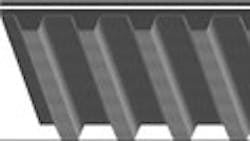Belt drives are used where the heavier flexible alternative, chain, is unnecessary or impractical. Belts are less expensive and require no lubrication, and they cause little wear on pulleys and sprockets. They can often handle speeds that chain cannot. Standard V or flat belts transmit loads primarily through traction with the pulleys, so they are fairly quiet, but they are prone to slippage and thus aren’t acceptable when shaft synchronization is required.
Synchronous belt drives fill the void between chain and ordinary belts – they overlap the other two in many applications, and they have advantages over them both. Synchronous belts, like V or flat belts, are not lubricated and are lighter than chain, but they have teeth (running on sprockets rather than pulleys), so they are not reliant on traction and do not slip. Synchronous belts engage sprockets with less impact than chain, dampen vibration, and are more apt for high-speed usage. These belts tend to stretch less than V-belts, which may get “squashed down” under load, with the decrease in cross section translating into excess belt length. With V or flat belts it’s also possible for traction and subsequent slip to cause the pulley itself to erode and thereby contribute to belt slack. Synchronous belts are commonly reinforced with fiberglass, while premium versions use a Kevlar derivative. Reinforcing gives them a low elasticity under tension, so their elongation is small and predictable.
Noise, however, can be a significant problem with these types of belts, being a waste of energy and a health detriment.
There are three components associated with synchronous belt noise. Impact between the teeth and sprocket causes a slapping sound. Also, as each belt tooth enters a sprocket cavity – and vice versa – air is compressed and forcibly evacuated, making a sound similar to air escaping from a balloon. Last, since a tight fit is required to control the mesh and minimize backlash between belt and sprocket teeth, the tensed belt can resonate like a plucked guitar string.
Synchronous belt noise increases exponentially with belt speed and pitch. Trapezoidal tooth profiles make abrupt face contact and tend to produce the worst sound levels, but round-tooth belts can also be quite noisy, especially at higher pitch line velocities. To illustrate the point, consider that the sound level for a round-tooth belt running on a 48-tooth sprocket at 3,500 rpm was measured at 92 dB. Running 30 drives like this simultaneously – easily imaginable – can produce quite a clamor if countermeasures are neglected.
Long-term exposure to excessive noise can be both psychologically and physiologically damaging. To combat noise and stay inside OSHA regulations, many facilities go as far as building foam-lined or lead enclosures around noisy machinery like synchronous belt drives. Another typical answer is to supply earplugs or earmuffs to the operators, sometimes doubling up the equipment worn. But traditional synchronous belts generate low-frequency sound that largely gets past these noise isolation and hearing protection devices; because such sound waves are long and travel far they can penetrate passive materials – even concrete.
Active noise control, or anti-noise, is one of the few truly effective ways to deal with low-frequency tones. Some very good, yet expensive hearing protection appliances cancel noise by meeting it with identical but out-of-phase sound (a “mirror image” of the offending noise). Each ear cup contains a microphone and a speaker; the microphone picks up the low frequencies and sends the signal to an active processor that regenerates the sound at a 180° shift, emitting it through the speaker. Destructive interference can be introduced through other arrangements as well. For instance, some systems blast anti-noise through speakers aimed directly at machinery.
Such contrivances, as they apply to synchronous belt drives, can be reduced if the belts themselves are designed better. Tooth geometry modifications can go a long way to minimize noise. The common objective is to alleviate the air entrapment that causes the rapid pressurization and outflow, and to reduce the impact between belt and sprocket teeth. One tooth configuration uses a dimple along the top of the tooth as an added escape channel for air, lessening its pressurization and exit velocity. And improving the rolling action of teeth as they mate flush is a widespread practice.
A more complex design uses two tracks of offset helical teeth to reduce noise through several mechanisms. The continuous sliding engagement mitigates the slapping observed in teeth that make instantaneous contact, and it also allows air to be displaced gradually. Furthermore, offsetting the tooth tracks by a half-pitch emulates the concept of active noise control, where a 180° shift in tooth engagement will lend to noise cancellation. Such a design causes a 15 to 19 dB reduction in noise compared with round tooth profiles.
Todd Hechler is in Business Development and Steve Anderson is a Chief Engineer with Goodyear Engineered Products, Lincoln, Nebr.
